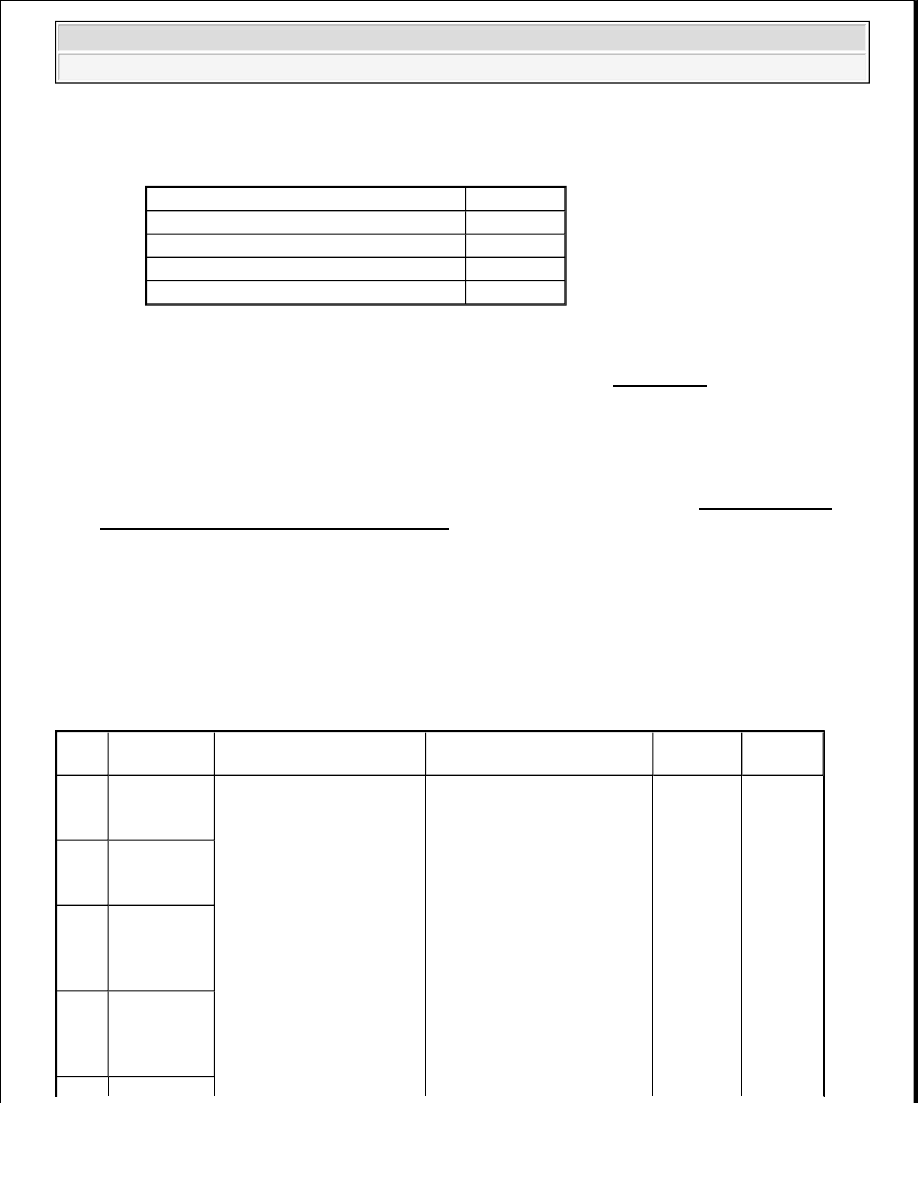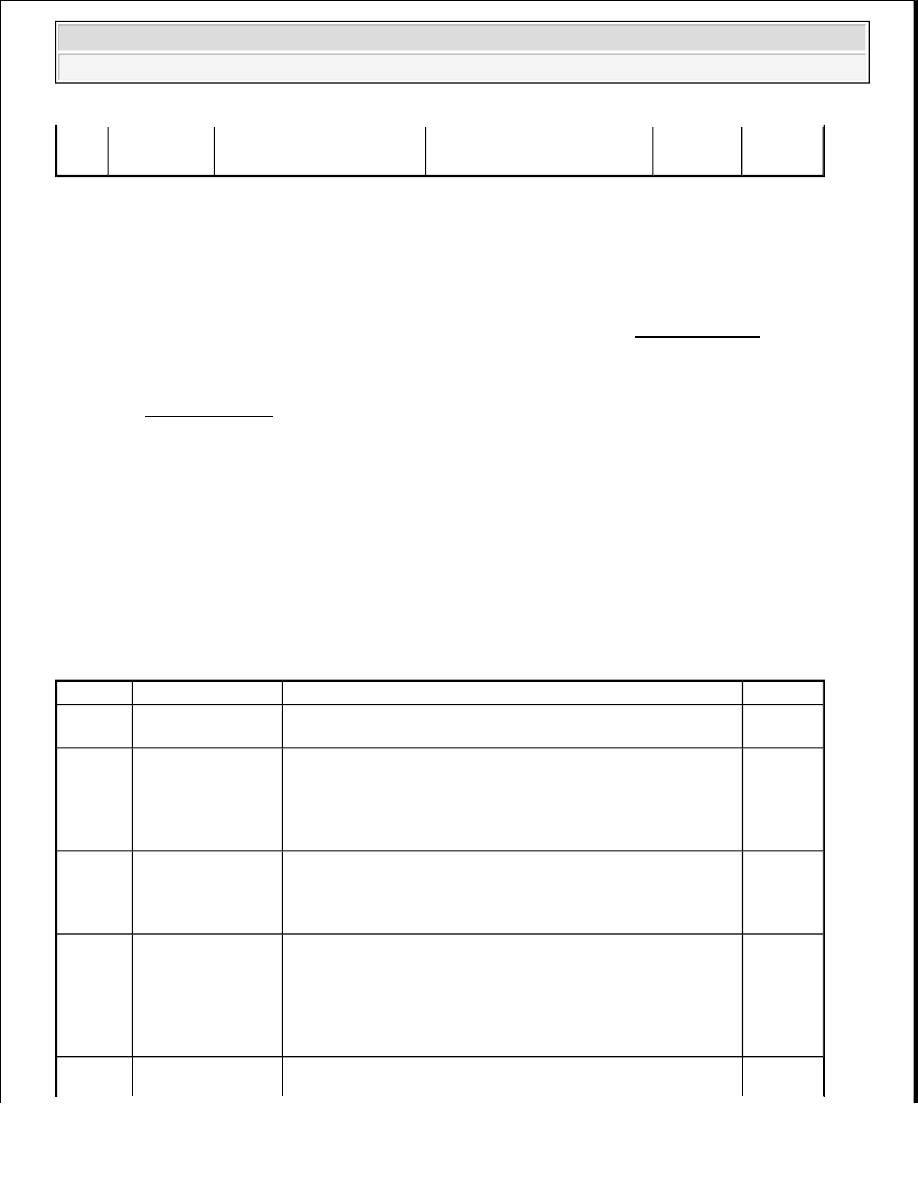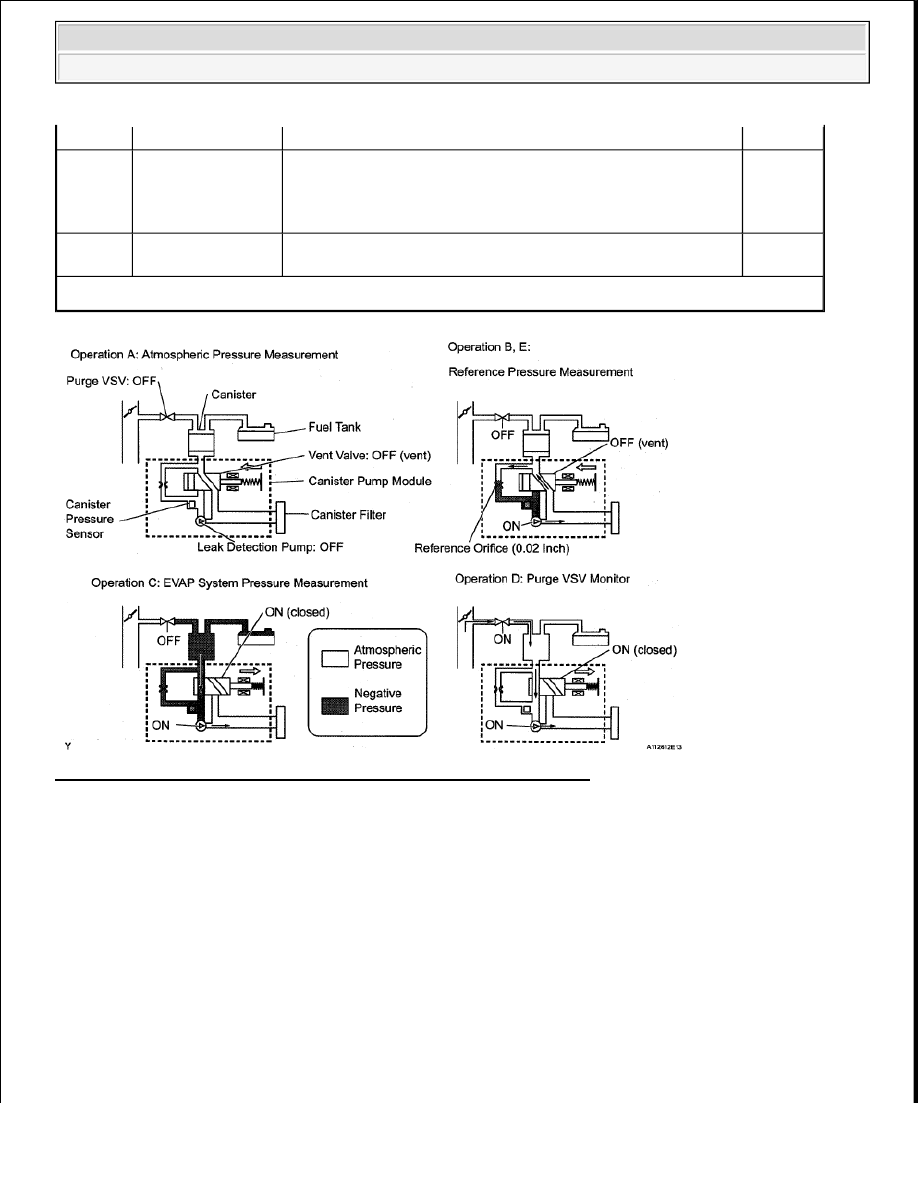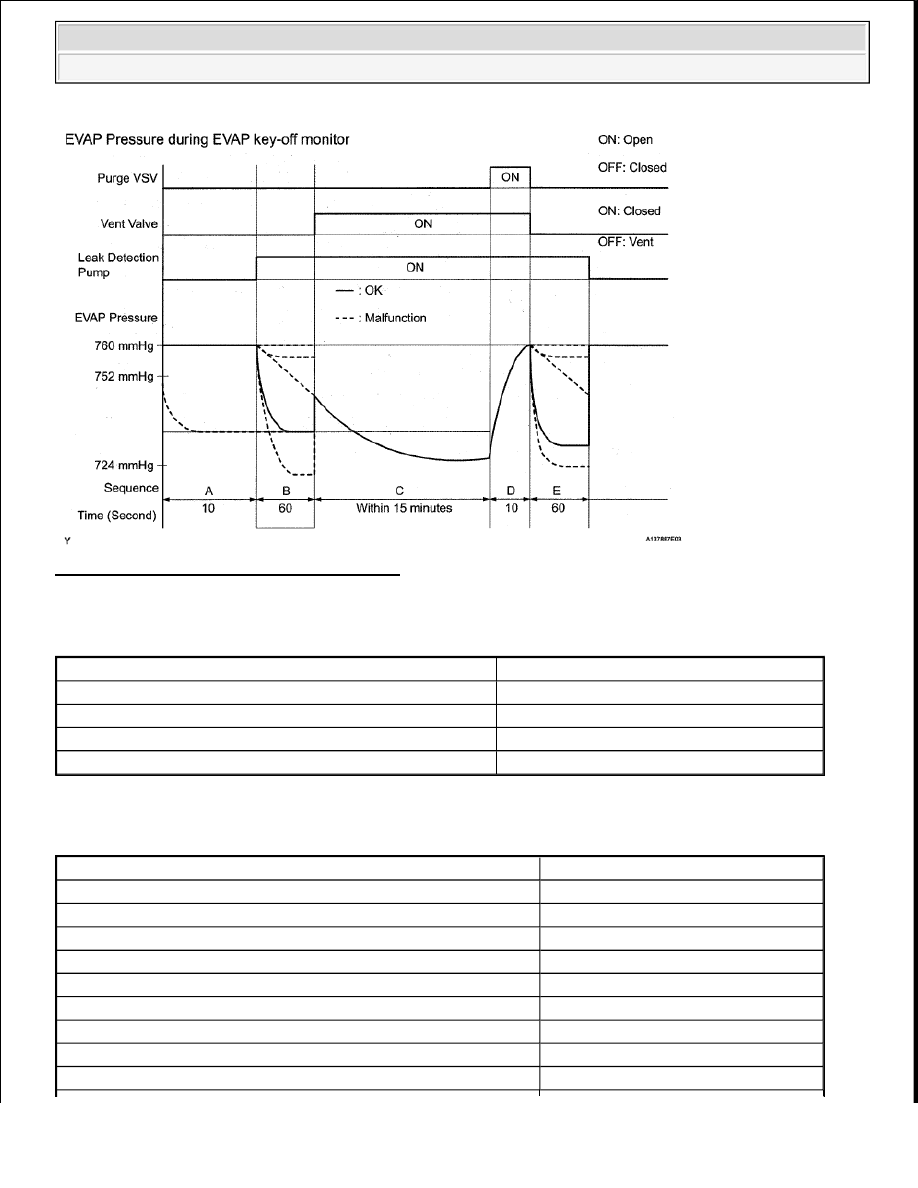Toyota Tundra. Manual — part 1208

Result
RESULT CHART
B : Go to step 6
C : REPLACE FRONT NO. 2 EXHAUST PIPE ASSEMBLY (See REMOVAL )
A : REPLACE EXHAUST PIPE ASSEMBLY
6. REPLACE FRONT EXHAUST PIPE ASSEMBLY
NEXT : REPLACE FRONT NO. 3 EXHAUST PIPE SUB-ASSEMBLY . (See EXHAUST PIPE
(FOR REGULAR CAB STANDARD DECK) ).
DTC P043E EVAPORATIVE EMISSION SYSTEM REFERENCE ORIFICE CLOG UP; DTC P043F
EVAPORATIVE EMISSION SYSTEM REFERENCE ORIFICE HIGH FLOW; DTC P2401
EVAPORATIVE EMISSION LEAK DETECTION PUMP STUCK OFF; DTC P2402 EVAPORATIVE
EMISSION LEAK DETECTION PUMP STUCK ON; DTC P2419 EVAPORATIVE EMISSION
SYSTEM SWITCHING VALVE CONTROL CIRCUIT LOW
DTC SUMMARY
DTC SUMMARY CHART
Result
Proceed To
P0420
A
P0430 (for Regular Cab Standard Deck)
B
P0430 (except Regular Cab Standard Deck) C
P0420 and P0430
A and B or C
DTC
Monitoring
Item
Malfunction Detection
Condition
Trouble Area
Detection
Timing
Detection
Logic
P043E
Reference
orifice
clogged
P043E, P043F, P2401,
P2402 and P2419 present
when one of following
conditions met during key-
off EVAP monitor:
Reference orifice
clogged
Reference orifice
high-flow
Leak detection pump
OFF malfunction
Leak detection pump
ON malfunction
Canister pump module
(Reference orifice, leak
detection pump, vent
valve)
Connector/wire harness
(Canister pump module
- ECM)
EVAP system hose
(pipe from air inlet port
to canister pump
module, canister filter,
fuel tank vent hose)
ECM
While
ignition
switch OFF
2 trip
P043F
Reference
orifice high-
flow
P2401
Leak
detection
pump stuck
OFF
P2402
Leak
detection
pump stuck
ON
2008 Toyota Tundra
2008 ENGINE PERFORMANCE Engine Control System (1GR-FE) - Tundra

HINT:
The reference orifice is located inside the canister pump module.
DESCRIPTION
The description can be found in the EVAP (Evaporative Emission) System (See DESCRIPTION ).
INSPECTION PROCEDURE
Refer to the EVAP SYSTEM .
MONITOR DESCRIPTION
5 hours* after the ignition switch is turned OFF, the leak detection pump creates negative pressure (vacuum) in
the EVAP system. The ECM monitors for leaks and actuator malfunctions based on the EVAP pressure.
HINT:
*: If the engine coolant temperature is not below 35°C (95°F) 5 hours after the ignition switch is turned OFF,
the monitor check starts 2 hours later. If it is still not below 35°C (95°F) 7 hours after the ignition switch is
turned OFF, the monitor check starts 2.5 hours later.
MONITOR DESCRIPTION CHART
P2419
Vent valve
stuck closed
Vent valve ON (close)
malfunction
Sequence
Operation
Description
Duration
-
ECM activation
Activated by soak timer 5,7 or 9.5 hours after ignition switch
turned OFF.
-
A
Atmospheric
pressure
measurement
Vent valve turned OFF (vent) and EVAP system pressure
measured by ECM in order to register atmospheric pressure.
If pressure in EVAP system not between 70 kPa-a and 525
kPa-a (570 mmHg-a and 825 mmHg-a), ECM cancels EVAP
system monitor.
10
seconds
B
First reference
pressure
measurement
In order to determine reference pressure, leak detection pump
creates negative pressure (vacuum) through reference orifice
and then ECM checks if leak detection pump and vent valve
operate normally.
60
seconds
C
EVAP system
pressure
measurement
Vent valve turned ON (closed) to shut EVAP system.
Negative pressure (vacuum) created in EVAP system, and
EVAP system pressure then measured.
Write down measured value as it will be used in leak check.
If EVAP pressure does not stabilize within 15 minutes, ECM
cancels EVAP system monitor.
15
minutes
(1)
D
Purge VSV monitor Purge VSV opened and then EVAP system pressure measured
10
2008 Toyota Tundra
2008 ENGINE PERFORMANCE Engine Control System (1GR-FE) - Tundra

Fig. 149: Monitor Description - EVAP System Pressure Measurement
The leak detection pump creates negative pressure through the reference orifice. When the system is normal, the
EVAP pressure is between 724 to 752 mmHg* and saturated within a minute. If not, the ECM interprets this as
a malfunction. The ECM will illuminate the MIL and set DTC if this malfunction is detected in consecutive
drive cycles.
*: Typical value.
by ECM. Large increase indicates normality.
seconds
E
Second reference
pressure
measurement
After second reference pressure measurement, leak check
performed by comparing first and second reference pressure.
If stabilized system pressure higher than second reference
pressure, ECM determines that EVAP system leaking.
60
seconds
-
Final check
Atmospheric pressure measured and then monitoring result
recorded by ECM.
-
(1)
If only a small amount of fuel is in the fuel tank, it takes longer for the EVAP pressure to stabilize.
2008 Toyota Tundra
2008 ENGINE PERFORMANCE Engine Control System (1GR-FE) - Tundra

Fig. 150: EVAP Pressure Graph On Monitor
MONITOR STRATEGY
MONITOR STRATEGY
TYPICAL ENABLING CONDITIONS
TYPICAL ENABLING CONDITIONS
Required Sensors/Components
Canister pump module
Frequency of Operation
Once per driving cycle
Duration
Within 2 minutes
MIL Operation
2 driving cycles
Sequence of Operation
None
Monitor runs whenever following DTCs not present
None
EVAP key-off monitor runs when all of following conditions met -
Atmospheric pressure
70 to 110 kPa-a (525 to 825 mmHg-a)
Battery voltage
10.5 V or more
Vehicle speed
Below 2.5 mph (4 km/h)
Ignition switch
OFF
Time after key off
5 or 7 or 9.5 hours
Canister pressure sensor malfunction (P0451, P0452 and P0453)
Not detected
Purge VSV
Not operated by scan tool
Vent valve
Not operated by scan tool
2008 Toyota Tundra
2008 ENGINE PERFORMANCE Engine Control System (1GR-FE) - Tundra

Нет комментариевНе стесняйтесь поделиться с нами вашим ценным мнением.
Текст